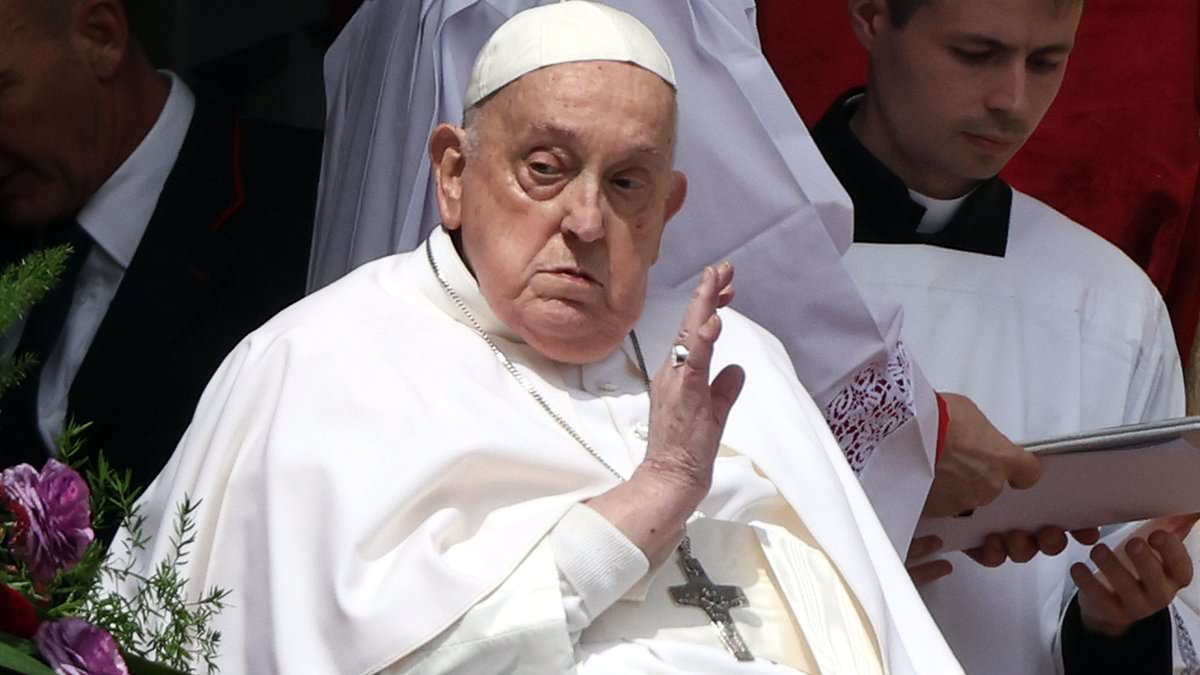The days following the death of Pope Francis are packed with centuries-old traditions and rituals – including his funeral and the public exhibition of his body.
The ageing 88-year-old had been battling ill-health after being admitted to hospital two months ago with an infection that developed into pneumonia.
His death was announced by the Vatican on Monday morning, sending the world’s 1.4billion Catholics into mourning.
Francis’s body is set to be moved into St Peter’s Basilica at the Vatican later this week, where he will lie in state for three days before his funeral.
No date has been announced for when this will happen. However, when Pope Benedict died on December 31, 2022, his remains were moved to St Peter’s three days later.
Hundreds of thousands of mourners are expected to visit the Francis’ embalmed body to pay their respects to the beloved leader of the Catholic church.
Ahead of lying in state, Vatican Chamberlain – currently Cardinal Kevin Farrell – will first officially certify that Francis is dead by calling his name three times at his bedside.
The Pope’s office and private apartments will then be sealed and the papal fisherman’s ring removed from his finger before being broken with a hammer.
The body of the late pontiff will then be dressed in red robes with a white mitre on his head, and he will be taken to St Peter’s Basilica, where he will lie in state for three days.
His funeral will take place within six days. A date for the ceremony has yet to be announced.
Traditionally, papal funerals are an elaborate affair, but before his death Pope Francis sought to simplify the ceremony.
Unlike his predecessors, the Pope said he did not want to be buried in the grottoes beneath St Peter’s Basilica at the Vatican.
At the end of 2023, the pontiff revealed he had ‘already prepared’ his tomb in the basilica of Santa Maria Maggiore in Rome’s Esquilino neighbourhood.
The church is one of the four major papal basilicas. Seven popes – from Honorious III in 1216 to Clement IX in 1669 – were buried there.
Francis will also be the first Pope in more than a century to be buried outside the Vatican.
The pontiff also scrapped the tradition of placing the Pope’s body on a raised platform – known as a catafalque – in St Peter’s Basilica for public viewing.
Instead, mourners will be invited to pay their respects while his body remains inside the coffin, with the lid removed.
And in a further break with tradition, new rites issued last year said Francis will be laid to rest in a single zinc-lined wooden casket.
Three caskets had traditionally been used for burying popes to create an airtight seal around the late pontiff’s body. They also allowed for objects, such as coins or papers issued by the pope during his reign, to be buried with the body.
Francis’s predecessor Pope Benedict XVI was buried in three coffins – including one made from lead – nested inside each other.
Benedict lay in state inside St Peter’s Basilica and was then buried in a crypt underneath the building.
Since St Peter’s was completed in 1626, 24 of 31 – more than three quarters – popes have been buried in its grottoes.
Pope Francis chose to pray at the basilica of Santa Maria Maggiore before and after trips overseas.
He made more than 100 visits to the fifth-century church, where he prayed in front of a sacred image of the Virgin Mary and baby Jesus.
Pope Benedict was buried in the same tomb that until 2011 was occupied by his predecessor John Paul II, who died in 2005.
The wooden lid on Benedict’s outermost coffin was decorated with a simple metal cross, the emblem of his nearly eight-year-long papacy and an inscription in Latin noting that he had lived 95 years, eight months and 15 days when he died on December 31, 2022.
The inscription also records the date his papacy ended when he went into retirement, on February 28, 2013, and became Pope Emeritus.
He was the first Pope in six centuries to retire.
Pope John Paul’s remains were moved up to a chapel on the main floor of the basilica after he was beatified in 2011.
Some two million mourners were thought to have visited him while he laid in state.
John XXIII, who died in 1963, was buried in a sarcophagus of marble beneath St Peter’s Basilica.
Since 2001, his body been on display in a glass sarcophagus underneath the altar of St Jerome in St Peter’s.
In the coffin, a written account of his historic papacy known as a rogito was also placed.
The coins minted during his pontificate and his pallium stoles, the religious garment worn over the pope’s robes, were also laid in the casket.
Pope Francis is still set to be lie in state in St Peter’s Basilica before his funeral.
Last year, the second edition of the ‘Ordo Exsequiarum Romani Pontificis’ (‘Funeral Rites of the Roman Pontiff’) updated the rites originally approved by Pope John Paul.
Instead of resting on a catafalque in St Peter’s during the lying-in-state period, Francis’s body will lie in his coffin, which will remain open until the night before his funeral, Vatican News reported.
And Francis’s death will be ritually verified in his bedroom, rather than in his private chapel.
The rites also state that he will be placed inside his coffin before being carried into St Peter’s.
